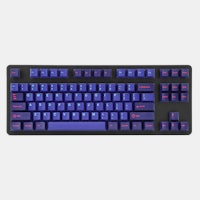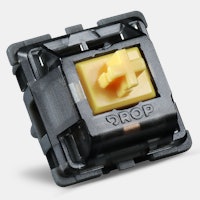Click to view our Accessibility Statement or contact us with accessibility-related questions
















If I Had to Start Frankenswitching

search
close
Sort by: Newest
keyboard_arrow_down
o2_designs
28
Aug 25, 2023
In my ventures into franken some switches, my favorite find is putting a Boba LT stem into a C3Equalz Kiwi housing and kiwi spring. Very interesting sound and feel to type on. I’ve been calling them Donatello’s due to their ninja turtle appearance.
thanks for the shout out for the Nosferatu image!! Good ole Dracula switches are amazing to use as well.
jrobins
30
Keyboard Club Member
May 12, 2023
I finally broke down and made a set of Cthulhus recently. It was quite the investment of time, effort, and money for what was ultimately a single set of switches. However, I can honestly say that it was worth it. My particular flavor uses Gateron Milky tops, Gateron Oil King bottoms (made of ink material), KNC “Average Joe” stems, Geon 22mm 65g springs (I think these were multistage, but I can’t remember off the top of my head), and a treatment of good old Krytox 205g0. I’ve included some thoughts about the individual components below.
Regarding the housings: I was surprised at just how nice these two components played with one another. They fit together like two pieces of a puzzle. I would imagine this isn’t always the case, even when both halves of the housing are manufactured by the same company. No films necessary, in my opinion. It may also be worth noting that the leftover parts aren’t worthless for either of these switches. The nylon bottoms of the Milky switches can be used for Black Cherry Pie frankenswitches. I’ll probably find a use for the Oil King springs as well... in hindsight I probably could’ve used them for the Cthulhus, but I’d already ordered the Geon ones. The tops of the Oil Kings are nylon, so they may eventually be useful as well.
Regarding the stems: I know Kailh Blacks are a budget-friendly and popular option for many Cthulhu makers, but I really liked the KNC Average Joes. They’re a bit pricey, but I found them to be super uniform in quality, and they’re polished for that extra bit o’ smoothness! Plus I kind of appreciated that I wasn’t left with spare Kailh parts that I probably wouldn’t have used.
Regarding the springs: I really enjoy the snappy return offered by slow/long springs (which to me means 18mm or greater). I don’t think that it’s important to get multi-stage ones like I did. I question how well these switches would work with really light springs (<50g), but I’m not going to knock something I haven’t tried for myself.
Lube: I think Tribosys 3204 would’ve worked well for the Cthulhus, but I wanted to get ‘em as smooth as possible, so I went with Krytox 205g0. Whichever lube you choose, just make sure you don’t overlube them, since there’s more investment at stake here compared to a typical set of “off the shelf” switches.
tl;dr: If you’re looking for a great linear frankenswitch to get you started, I highly recommend making yourself a set of Cthulhus!
ThatPotatoGuy
5
Jan 24, 2024
jrobinsHey, I'm thinking of putting milky yellow tops on gateron oil kings without changing anything else. Do you think it would be worth the effort? Would it make a noticable difference (in my case I'm hoping to achieve a deeper/ more muted sound)
jrobins
30
Keyboard Club Member
Feb 3, 2024
ThatPotatoGuySorry for the slow reply @ThatPotatoGuy . I would imagine the main difference you’d see (er… hear) is a deeper sound on the upstroke/return. If you’re looking for a muted sound signature, you could try adding some foam… that usually seems to help achieve a more muted sound. Let us know how it turns out!

The_Manic_Geek
427
Keyboard Club Member
May 9, 2023
As a heads up to anyone thinking of trying Frankenswitching things with Everglide Aqua King bottom housings: the leaves are far too weak to handle tactile stems. Tried swapping a Crystal Violet stem into one of my AK housings, and it immediately warped the leaf to the point of not being usable.
Then again my experience with AK's has been trash (I was part of R1 with the jacked up top housing fitment with the stems, some of my switches wouldn't even rebound after pressed when bone dry), so take my tale with a grain of salt.
Great article!
(Edited)
Artidek
2
May 5, 2023
Ive tried milky yellow and cherry housings. Cherry top and milky bottom is pretty nice and works well but depending on the switch, milky tops and cherry bottoms may have some closing issues. They will close its just that the legs may stick out a bit which may result in it being kinda hard to put in and may even break the legs.
EnKeyDu
2
May 5, 2023
Thanks for the fun read! I've tried to do a little frankenswitching before, but never anything crazy. Now this gives me ideas with what I do have try out different combos.
Brimmy
2
May 4, 2023
i heard about Frankenswitching from Keybored when he posted a video saying he made the quietest keyboard
one of these days i'll have the money to put together my own quiet keyboard :3

The_Manic_Geek
427
Keyboard Club Member
May 9, 2023
BrimmyI recommend trying out Haimu Heartbeats if you're looking for a solid silent switch to experiment with 👌
PRODUCTS YOU MAY LIKE
Trending Posts in Mechanical Keyboards
The-Cindy
This is easily my new favorite keeb
The IDOBAO ID80 Crystal Gasket Keyboard Kit is a standout choice for mechanical keyboard enthusiasts seeking both aesthetics and performance. Its transparent acrylic case beautifully showcases the...
Dec 20, 2024
Squizzle
Keyboard & Drink
Shine-Through LOTR Keycaps Concept
Would anyone else be interested in a shine-through set of LOTR keycaps? Imagine a glowing black speech keycap set that seduces like the one ring. Perhaps the pale blue moonlight glow of the elven...
Dec 20, 2024
Akofena
Are shipments to Argentina safe?
I want to buy a keyboard with some keycaps ! but i live in argentina. ty
Dec 17, 2024

tbui
Absolutely stunning
The colors really pop on a white board. Easily one of the best caps I own!
Dec 17, 2024
bobbibeer1976
False Advertising BEWARE
This company should be ashamed of themselves. Advertising to young people who save all their money and want nothing more than a keyboard and advertise to them that it is in stock and will be shipped asap and they will arrive before Christmas. Only to "ship" and package and get their hopes up and it arrives and there is no keyboard in the package. Then to get on the website and it isn't even going to ship until January. This happens AFTER you have received their money and made promises that it was arriving, on it 's way, etc! Shame Shame on you!!!
Dec 16, 2024

EuclideanGambit
Closest profile to MT3
I really enjoy the MT3 profile, it has actually become kind of difficult to type on other profiles. So I was looking for some that might be close and noticed the SA profile. I was wondering if there were anymore that were close to it. This would open my options significantly when shopping around.
Dec 15, 2024

bebo2
timing of delivery
I am wondering how much time does order takes to be delivered, when i was ordering site showed me it would takes from 3-5 business days is that accurate or it takes more time to be delivered
Dec 15, 2024













Figure 1: Not quite the monster movie that goes with 'frankenswitch', but ol' Dracula and his frankenswitches just fit the vibe too well to be left out of this article. Image credit to @o2_designs Even though I haven’t quite had a chance to cover frankenswitches much in writing, many people still like to ask me if I care about them, collect them, or even make them for my own keyboards. As to the first two questions, the answer is most certainly yes, though only ones of historical value and community-wide interest. Switches such as Holy Pandas, Ergo Clears, Gatistotles, Zykos, etc. are all inarguably important frankenswitches that have had an impact on the modern keyboard hobby and should absolutely be tried by any and all people who build a custom keyboard. Regarding the latter question, though, I don’t frankenswitch nearly as much as I used to back when I first joined the hobby. However, in the interest of providing a starting point for new people to look into making their own frankenswitches, here’s some components I would start out exploring, given all my switch knowledge that I have now, that might lead to some interesting results with enough messing around… Top Housings
After having officially narrowed down the effectively infinite list of frankenswitches out there to a few dozen potential combinations for you to start out with, I now officially push the onus on you to go out and explore. While it’s not likely that you’ll stumble across the next community-altering combination in switch components, there’s a very realistic chance you’ll come across a patchwork style switch which is not only unique to you and your tastes, but just may be your true endgame switch. However, if you’re still a bit interested in learning more about switches prior to dropping some money on frankenswitch components, consider checking out my other switch articles here on Drop such as ‘The Who’s Who of Switch Manufacturers’ or ‘Switch Marketing Terms: What to Know and What to Ignore’.